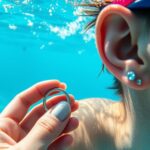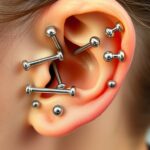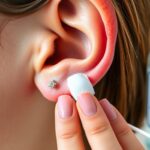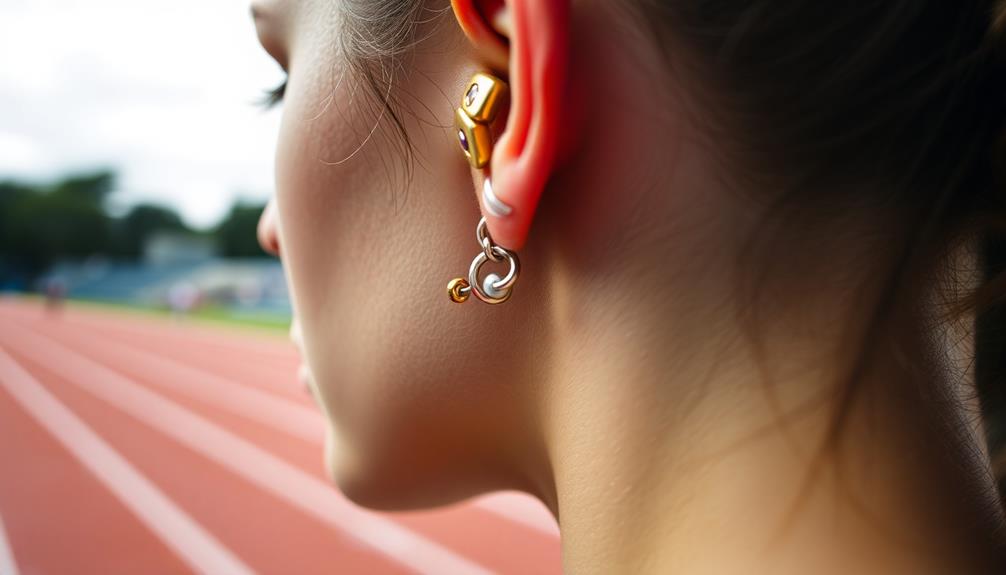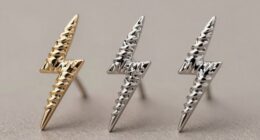To guarantee your piercings stay safe while scuba diving, choose pressure-proof jewelry made from materials like surgical stainless steel, titanium, or niobium. Avoid cheap or porous jewelry that can harbor bacteria or degrade underwater. Wait until your piercings are fully healed before diving to reduce complications. Make sure your jewelry fits snugly but comfortably, and practice pressure equalization techniques during descent and ascent. Keep these tips in mind to dive confidently and safely—more details can help you stay prepared.
Key Takeaways
- Choose pressure-resistant jewelry materials like surgical stainless steel, titanium, or niobium for underwater activities.
- Wait several months after piercing before diving to ensure complete healing and reduce pressure-related risks.
- Ensure jewelry fits snugly but comfortably to prevent movement and tissue irritation during dives.
- Use proper pressure equalization techniques, such as swallowing or pinching the nose, during descent and ascent.
- Regularly inspect and maintain jewelry to confirm it remains secure and suitable for underwater pressure changes.

If you’re a scuba diver with new or existing piercings, understanding how pressure changes underwater can help you avoid discomfort or damage. When you dive, the increasing pressure can affect your jewelry and the healing process, especially if you haven’t taken proper precautions. Knowing how pressure impacts piercings lets you plan better and enjoy your dives without worry. One key factor is the jewelry materials you choose. Some materials, like surgical stainless steel, titanium, or niobium, are less likely to cause irritation or react negatively under pressure. These materials are biocompatible, lightweight, and durable, making them ideal for underwater adventures. Avoid porous or inexpensive jewelry, such as plastic or cheap metals, because they can harbor bacteria or degrade more easily when exposed to moisture and pressure changes.
As your pressure increases underwater, it can cause your jewelry to press against the piercing site, potentially leading to discomfort or even tissue damage if the jewelry isn’t suitable. That’s why selecting pressure-proof jewelry made from appropriate materials is essential. Additionally, the healing process plays a significant role. If your piercing is fresh, it’s more vulnerable to pressure-related issues like swelling, pain, or even rejection. Diving too soon after getting pierced can exacerbate these problems, so it’s best to wait until your piercing is fully healed—usually several months—before diving regularly. During the healing process, your body is more sensitive, and improper jewelry materials can cause prolonged healing or infections, especially when exposed to saltwater and pressure.
To ensure your piercings withstand underwater pressures, always check that your jewelry fits snugly but isn’t too tight. A well-fitted piece minimizes movement and reduces irritation. If you’re planning a dive, consider removing or switching to pressure-proof jewelry designed for underwater use, especially if your piercing is still healing. Also, avoid changing jewelry immediately before a dive, as this can introduce bacteria or cause accidental injury. Remember that even with pressure-proof jewelry and proper timing, equalizing pressure during descent and ascent is crucial. Use techniques like swallowing or gently pinching your nose to help your ears and piercings adjust gradually, preventing unnecessary strain. Additionally, being aware of pressure changes and how they influence your body can help you better prepare for safe diving experiences.
Frequently Asked Questions
Can Pressure-Proof Piercings Be Safely Worn During Deep-Sea Diving?
You might wonder if pressure-proof piercings are safe during deep-sea diving. These piercings help with pressure equalization, preventing discomfort or damage. They’re designed to be water-resistant, reducing risks of infection or loosening. However, it’s vital to make certain your piercing is fully healed and properly sealed before diving. Always consult your piercer or dive professional to confirm if your pressure-proof jewelry can handle the extreme pressure changes underwater.
What Types of Piercings Are Best Suited for Underwater Activities?
When choosing piercings for underwater activities, you should prioritize jewelry durability and skin compatibility. Opt for sturdy, corrosion-resistant materials like titanium or surgical steel to prevent damage and irritation. Choose designs that minimize snagging or movement, reducing the risk of injury during swimming or diving. By selecting the right jewelry, you guarantee comfort and safety, allowing you to enjoy aquatic adventures without worry.
How Long Does It Take for Pressure-Proof Piercings to Heal Completely?
You might think pressure-proof piercings heal overnight—nope, not quite. The healing timeline varies, but generally, it takes about 6-12 weeks for complete healing. During this period, you need diligent piercing care to avoid complications. Patience is key; rushing could extend healing time or cause issues. So, keep up with your piercing care routine and give your body the time it needs to heal fully.
Are There Specific Materials Recommended for Pressure-Proof Piercings?
When choosing materials for pressure-proof piercings, you should look for biocompatible metals and hypoallergenic materials. These options help reduce irritation and promote healing, especially under pressure changes during diving. Stainless steel, titanium, and niobium are popular choices because they’re durable, safe, and unlikely to cause allergic reactions. Always guarantee your piercings are made from high-quality materials to avoid complications and enjoy safe diving experiences.
What Should I Do if My Pressure-Proof Piercing Causes Discomfort Underwater?
Oh no, your pressure-proof piercing is causing discomfort underwater—what a shocker! First, stop diving immediately to reduce infection risk. Gently rinse with sterile water and avoid touching it with dirty hands. Prioritize good hygiene practices to prevent complications. If pain persists, ascend slowly and consider consulting a dive medic or piercer afterward. Remember, ignoring discomfort can turn your underwater adventure into a bacterial horror show!
Conclusion
So, now you’re ready to conquer the depths with your pressure-proof piercings! Forget worries about underwater pressure turning your jewelry into a ticking time bomb—your piercings are practically invincible, like underwater superheroes. Dive confidently, knowing your piercings won’t burst, crack, or vanish into the abyss. With these tips, you’ll rule the ocean with the coolest, most pressure-resistant bling in the entire underwater universe. Get ready to make waves—literally!



